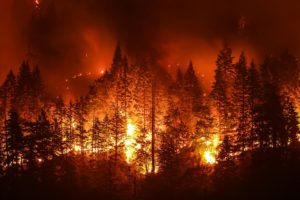California is no stranger to the danger of wildfires. In recent years, these devastating wildfires have caused billions of dollars worth of damage, destroyed entire communities, and disrupted countless lives. These fires start for various reasons, from natural phenomena such as lightning strikes to human-caused factors. But what are the primary causes of these fires, and how much destruction do they ultimately cause?
In this blog post, we’ll explore the various causes of California wildfire and examine the damage they can inflict.
What Is a Wildfire?
A wildfire is an uncontrolled fire that burns in a natural environment, usually a forest or grassland. Wildfires are most likely to start during periods of rising temperatures and drought conditions when the dry vegetation provides fuel for the fire to spread quickly.
Science Behind Wildfires
Wildfires are complex phenomena that occur when three conditions are met: fuel (such as dry wood, grasses, and trees), oxygen, and a heat source. A fire will only start if enough fuel and oxygen are available to support combustion and a spark or other heat source to start the process. Once a wildfire begins, it can spread through the environment quickly and create its own oxygen supply by burning through combustible material.
The trajectory and duration of wildfires are dependent on several factors. Drought and high temperatures can make fires more likely, as can strong winds that carry embers and increase the speed of the fire’s movement. Other conditions, such as low humidity or land management practices like logging, can also contribute to igniting wildfires.
Natural Causes
Natural elements, such as lightning or dry conditions, can cause wildfires. From strong winds to extreme heat and dryness, numerous factors in California’s climate and environment can lead to devastating wildfires.
Lightning
Lightning is the most common cause of natural wildfires. When lightning strikes a dry patch of vegetation, it can spark a blaze that quickly spreads out of control. The National Park Service estimates that up to 90 percent of all wildfires in the United States are started by lightning.
Volcanoes
Volcanic eruptions can spew lava and volcanic ash across vast distances, igniting nearby vegetation. This is particularly dangerous when the lava reaches forests or other combustible material. While California is known for earthquakes, floods, and landslides, volcanoes are just as real of a hazard when considering California’s potential for natural disasters.
Human Actions
Wildfires can start due to acts of nature or due to human actions. Fires started by humans range from intentional to unintentional. According to the National Fire Protection Association, in 2017, nearly half of the wildfires reported were caused by humans, such as arson.
Arson is the act of intentionally setting fire to a property, and it’s one of the most common causes of wildfires. It’s a criminal act that can have devastating consequences for ecosystems, communities, and wildlife. Unintentional fires can also be started indirectly by human negligence. This could include leaving a campfire burning or not properly disposing of cigarettes.
California Climate and Vegetation
- Drought: When an area experiences an extended period of dry weather, it increases the risk of a wildfire. Without regular rain, the vegetation becomes drier and more likely to catch fire from any spark or heat source.
- Insects: Certain insects, such as bark beetles, can spread disease among trees and shrubs, which makes them more prone to catching fire. Beetles are known for burrowing into trees and creating tunnels that can serve as pathways for wildfire flames.
- Wildfire-prone plants: Certain types of plants, such as grasses and shrubs, are more susceptible to catching fire than others. These plants tend to dry out quicker and produce a great deal of fuel for a potential fire.
Climate Change
Climate change has also been linked to an increase in the frequency and severity of wildfires domestically and elsewhere worldwide. Aside from natural causes like lightning strikes or abandoned campfires, climate change has made them more common than ever before.
As the average global temperature increases, dry areas get drier and wet areas get wetter. Warmer temperatures specifically mean reduced snowpack and earlier spring melts, which reduces water availability when the dry vegetation provides fuel for the fire to spread more quickly.
Climate change has intensified summertime droughts, reduced snowpacks, increased lightning strikes, and lengthened the fire season – all factors that lead to more wildfires
California wildfires can be started by several different factors, including:
- High temperatures
- Low humidity
- High winds
- Dry vegetation
Combination of Human Factors and Nature
A combination of human negligence and natural causes wildfires in California. Rising temperatures, drought conditions, and dry vegetation create the perfect environment for uncontrolled blazes. It’s estimated that people cause 90 percent of wildfires in California, either through deliberate acts of arson or accidental activity such as controlled burns gone wrong, suppressing wildfires, and failing to maintain fire equipment properly.
Wildland-Urban Interface
The Wildland-Urban Interface (WUI) is an area where development mixes with natural lands and is at a higher risk of destructive wildfire. California is uniquely positioned to have more of these areas due to its topography and population density. WUIs are common in regions with a high concentration of combustible materials, like dead trees and dry brush, and also have roads, buildings, and other structures that can ignite or spread the fire.
Deforestation
Forests once filled with trees are now barren landscapes due to human deforestation. Commercial producers of timber have cut down a portion of California forest.
Electric companies also have a history of cutting down live vegetation around power lines and facilities. The more tree leaves and branches that litter the ground, the easier it becomes for fires to spread. The lack of trees also means less shade for plants and animals, which can lead them to die from heat exhaustion or dehydration during droughts – contributing even further to fire risk.
Pacific Gas & Electric
Human factors or downright criminal negligence have caused the majority of damages from wildfires in California. While deforestation, urbanization, and climate change are all ways humans have indirectly contributed to wildfires, a major California utility company has been directly linked to billions of dollars of damage and dozens of deaths.
Pacific Gas & Electric Company provides electricity and gas to many residents in the state. PG&E equipment, such as power lines, can become faulty due to age or improper maintenance.
The resulting sparks from the utility’s equipment coming into contact with dry vegetation are often enough to ignite a wildfire. In 2018, the Carr Fire was linked to a failure with Pacific Gas & Electric’s equipment. Similarly, the Kincade Fire in 2019 resulted from a faulty piece of equipment operated by PG&E Corporation.
Negligence or Arson?
Criminal negligence is defined as a conscious disregard for the safety of others or of one’s legal duty to exercise reasonable care in a situation with a foreseeable risk of harm. The difference between criminal negligence and arson is that while arsonists set fires intentionally, criminal negligence stems from unintentional recklessness.
Negligence occurs when someone fails to take reasonable action and instead acts carelessly or recklessly and causes injury or property damage. In this case, you can hold companies like PG&E liable for criminal negligence as their failure to maintain their equipment or take necessary precautions resulted in catastrophic destruction.
Damages of Wildfire in California
 Wildfires cause widespread destruction in a very short time. Hundreds of thousands of acres in California have been scorched, and homes and businesses destroyed. These fires’ environmental, economic, and non-economic effects can be devastating, often leaving many with ash and rubble.
Wildfires cause widespread destruction in a very short time. Hundreds of thousands of acres in California have been scorched, and homes and businesses destroyed. These fires’ environmental, economic, and non-economic effects can be devastating, often leaving many with ash and rubble.
The effects of a wildfire on the environment can be extensive and long-lasting. Trees and wildlife habitats can be destroyed, and soils become barren due to the loss of vegetation. Smoke, ash, and dust can linger in the air for months, leading to hazardous air quality and unhealthy breathing conditions. Additionally, runoff from the ash can contaminate rivers, streams, and groundwater with heavy metals and other toxins.
Non-Economic Damages
Aside from physical destruction, wildfires can cause many psychological and emotional issues. People are often forced to flee their homes, and the chaos and displacement disrupt their lives. This is especially true for those who have experienced personal loss or tragedy due to the fire. Moreover, those living in areas affected by wildfires may suffer from anxiety, depression, trauma, and post-traumatic stress disorder.
Economic Damages
Wildfires can also have profound economic implications. The cost of rebuilding homes and businesses and the lost earnings associated with evacuation and displacement can be astronomical. Insurance companies must also pay out massive sums for property damage claims. Furthermore, companies providing utilities such as electricity and gas may be liable for damages caused by power lines or pipelines damaged by the fire.
Wildfires significantly threaten people’s safety, health, homes, and livelihoods. It’s essential to understand the full scope of the devastation they can cause to prepare for the risks they pose properly. Understanding these disasters’ environmental, economic, and non-economic impacts is essential to ensuring that everyone affected receives fair compensation for their losses.
Wildfires are an issue all over the country, but these burning forests have been particularly devastating on the west coast of America. Many factors contribute to these wildfire outbreaks, such as drought, heat waves, and increased levels of atmospheric carbon dioxide, which dry out trees and vegetation making them more susceptible to ignition by lightning or humans. The electrical grid is also a contributing factor because power lines can act as a high-tension wire that carries electricity from power plants to cities and towns for distribution.
California Wildfires: Negligence in a Combustible Climate
California’s warm, dry climate has long been seen as one of the main contributors to the prevalence of wildfires in the area. Rising temperatures and drought conditions can lead to arid vegetation, making it easier for fires to start and spread quickly.
In addition, strong winds can help to spread the flames across great distances in a short amount of time. Even a lightning strike can cause a wildfire in the right conditions, such as dry underbrush and high winds. But negligence is most often the cause of wildfires, resulting in economic implications.
If a wildfire damaged your business or home, contact a California Wildfire lawyer for guidance on recovering expenses for evacuation and fire damage.
